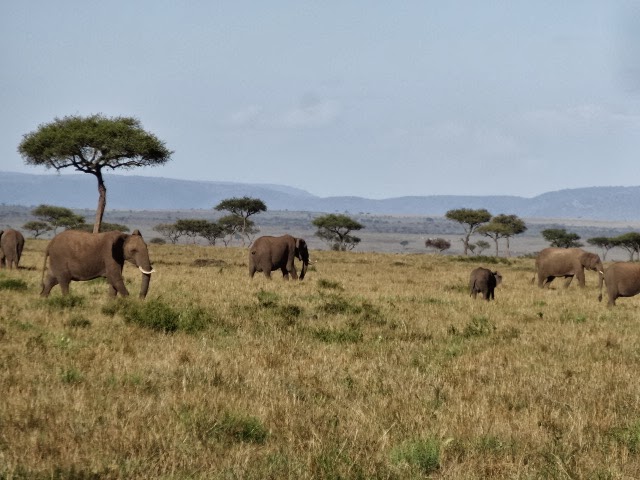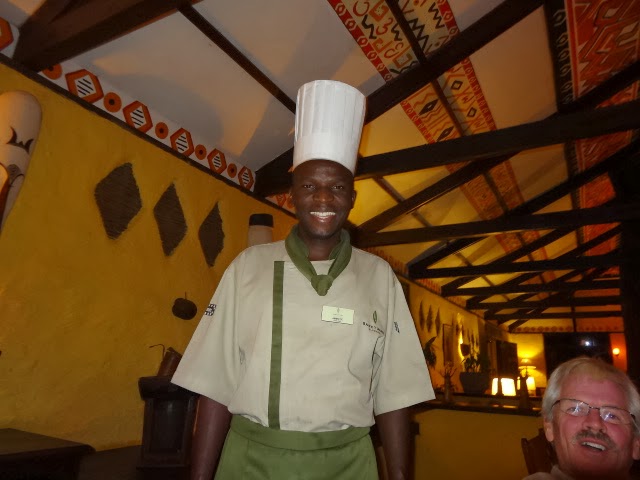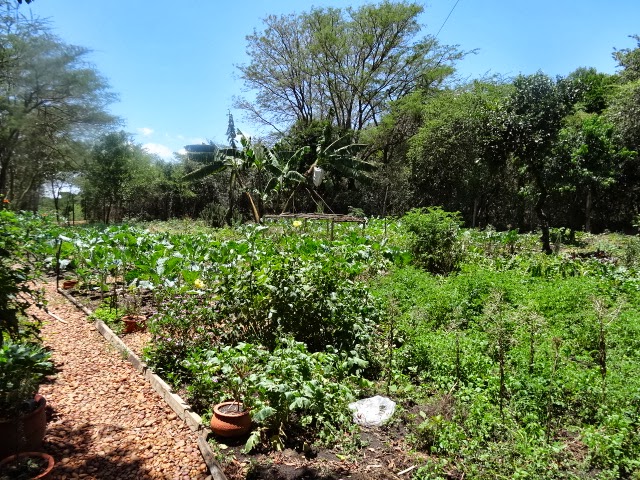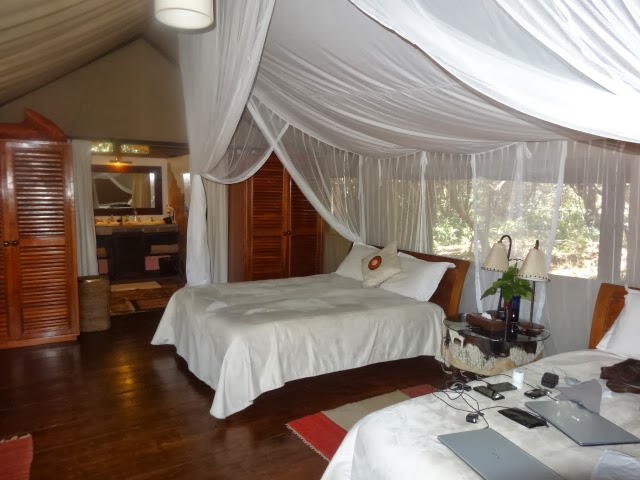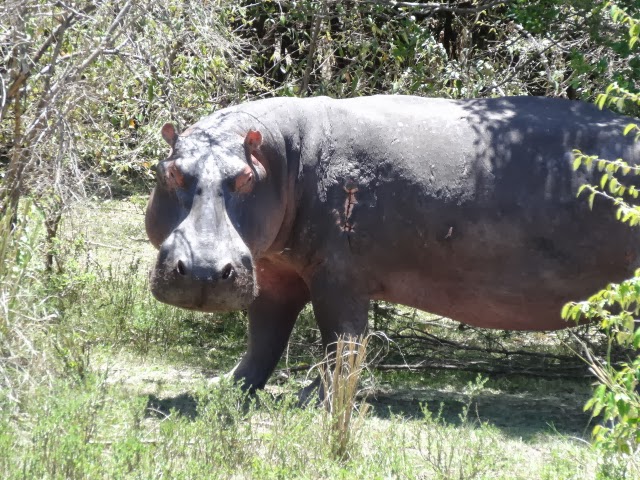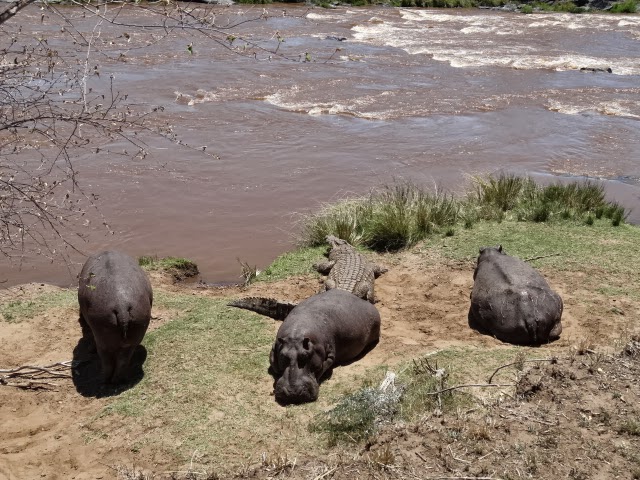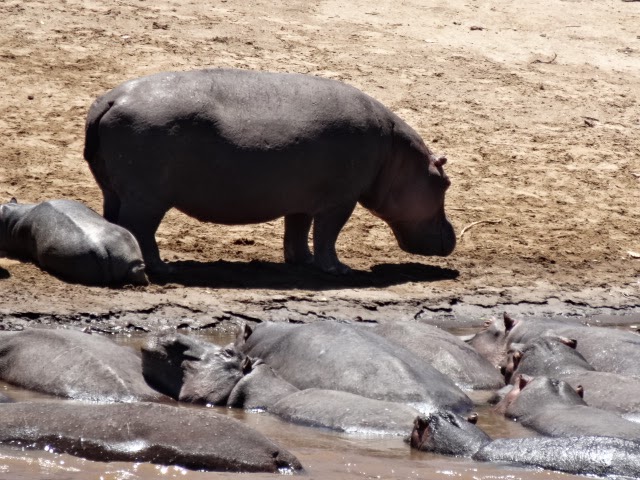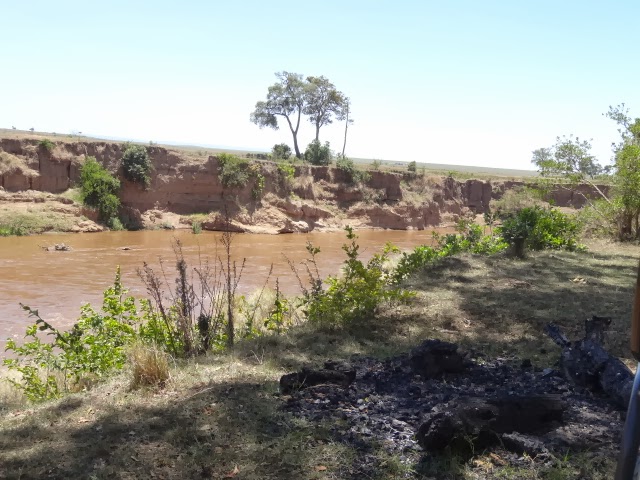
 |
||
| Warthogs, rather humorous characters, kneel on their front legs while grazing.
Some may say that warthogs are not worthy of many photos, but our safari group found them to be interesting, attentive, and totally fearless of us as provided we didn’t make sudden movements.
Each morning at 6:30 am sharp, we’d pile into the Land Cruiser without a plan, Anderson at the wheel, to go on the search for the next great sighting, the next great photo. With a cooler filled with chilled beverages, including beer, and on two mornings, a picnic basket filled with scrumptious breakfast goodies made fresh only minutes ago, off we went, expectations at peak levels.
 We were never disappointed, especially not after seeing that which we’ll continue to share over the next several days including, our warthogs/lions story with photos today.  This young male lion lay in wait as he kept his eye on the warthog babies, a more manageable meal than the adult warthog.
The air was cool and crisp at 5000 feet above sea level this early in the day. We’d brought along jackets, putting them on only minutes into the drive as the cool wind whipped in our faces as we bounced along the rough roads.
 Anderson explained that the female lions do most of the hunting to later have their kill taken over by a nearby awaiting male. Fortunately, when no male is within sight, she can keep the kill for herself and her cubs. The male lion after mating leaves the female to continue his life, although he may hover in the area of his family in order to partake of her kills.
I wore a BugsAway hat while on safari for a few reasons, one to keep my hair from obstructing my view and two, to keep insects away from my face and neck. The entire time in the Masai Mara both Tom and I wore our BugAway clothing
day and evening.
 Difficult to see all the action, the mother warthog pushed her babies into a hole in the area of these bushes, often left by aardvarks. Mother warthog couldn’t also fit in the hole, thus she stood back a distance from her secured babies.
Complimentary laundry service was provided by Camp Olonana allowing us to wear fresh clothing each day. Covered with dirt and dust by the day’s end there was no way to wear the same pants and shirt more than once. Freshening up before dinner each night wasn’t an option when we returned to camp around 7:00 pm. We just stayed in our dusty clothes from the safari, wearing fresh the next day.
 Mother warthog stood back a safe distance from the lions, hoping her little ones would be spared if the lions were eventually distracted by a more meaty opportunity. Anderson explained we could wait all day to see what would transpire. Note the two other safari vehicles in the background, its occupants also entranced by this worrisome event. Both Tom and I had accepted that we may see an actual kill in the wild, which we eventually did realize it’s all a part of the life cycle.
Dressing up for dinner wasn’t important to us. All we wanted was to be on safari, eat when necessary, sleep enough to refresh us, post what we could get online, and revel in our surroundings every single moment. That’s exactly what we did.
 ” I’m getting bored sitting here waiting for these mere appetizers. Let’s move onto something bigger and juicier,” lion says.
 The female lion scans the area as she waits for the baby warthogs to reappear.
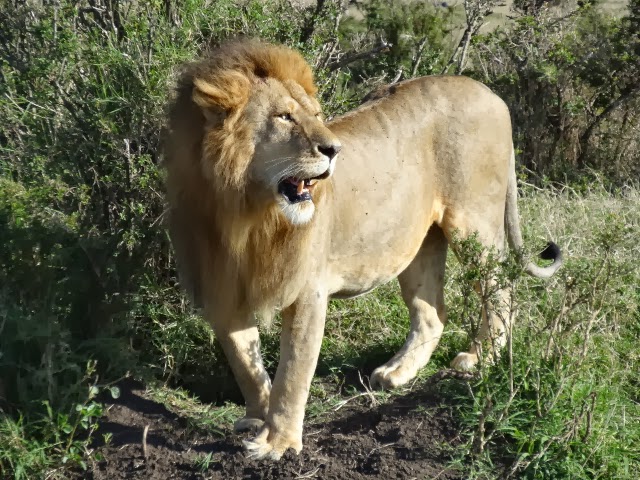 The male lion continues his wait for the warthog babies to appear.
 The female lion never loses interest in the possible kill while the male languishes appearing bored and disinterested until there’s some “real action.”
Many others hadn’t been out for as many hours as we had. Anderson was determined to give us the time of our lives. Most visitors went on a three-hour morning drive and a two-hour late afternoon drive.
 “I’ve had it,” the male lion says. “You’re on your own, Misses.”
This schedule left the guests time for lounging by the pool, sitting on their verandas overlooking the river, and dining on three meals a day of fabulous food. We barely had two meals a day and, the entire time at Camp Olonana, we rested on our veranda for less than one hour total. We didn’t care.
 We never failed to be excited to see an elephant, their massive size and majesty continuing to astound us.
 Elephant family on the move. Mom is holding up the rear, keeping a watchful eye on her offspring.
For us, it was almost eight hours each day on safari, a rare treat, appreciated by our safari mates, of which there were two on one day and four on the other days. None of us couldn’t get enough.
 Male lion taking a break from his zebra meal.We shot this photo within 25 to 30 feet.
We were the only pair in our group never missing a game drive, except for the commitment we’d made to visit the Masai Village at 10:30 in the morning on the day we flew back to Diani Beach.
An extraordinary experience in itself, we’re grateful we didn’t miss the visit with Chief Richard and his extended family. (We’ll share photos and the story of the Maasai’s sparse lifestyle in the next few days, for which I wrote notes on my smartphone while flying back on the tiny plane to ensure I didn’t forget a tidbit).
 He opened his eyes, giving us a toothy grin. He didn’t seem concerned, we were close, but we were quiet and nonthreatening.
The story of the warthogs and lions will be told in the captions in the photos included here.
 Zebras are common in the bush. We’ll have plenty of Zebra photos when we live in South Africa in less than two months, where they’ll visit almost every day.
 We often saw giraffes hanging out in groups.
|


 |
| A male impala based on the black striped on its hind end, a graceful animal, one of many in the deer/antelope family. There were many varieties, often hard to distinguish one from another. |
Later in the day, from a distance, we spotted a pride of lions, a mother, and her cubs lounging under the shade of a tree. Little did we know until Anderson drove us within 20 feet, that they had a kill they were voraciously working over.
 |
| Mom growled in seeming happiness over her successful hunting day, without a single male in view to confiscate their meal. |
 |
| Life is good. |
 |
| The cubs took a break to relax. |
 |
| Moments later they were back at their meal again. |
 |
| The cubs enjoyed the meal while mom stayed back keeping an eye out for danger. |

 |
| Finally, mom steps in for a bite. |

 |
| Cubs sharing. |
 |
| Tom was having a beer in the late afternoon, in awe of what we’ve experienced, having never expected it to be so rewarding and fulfilling in many aspects. |

